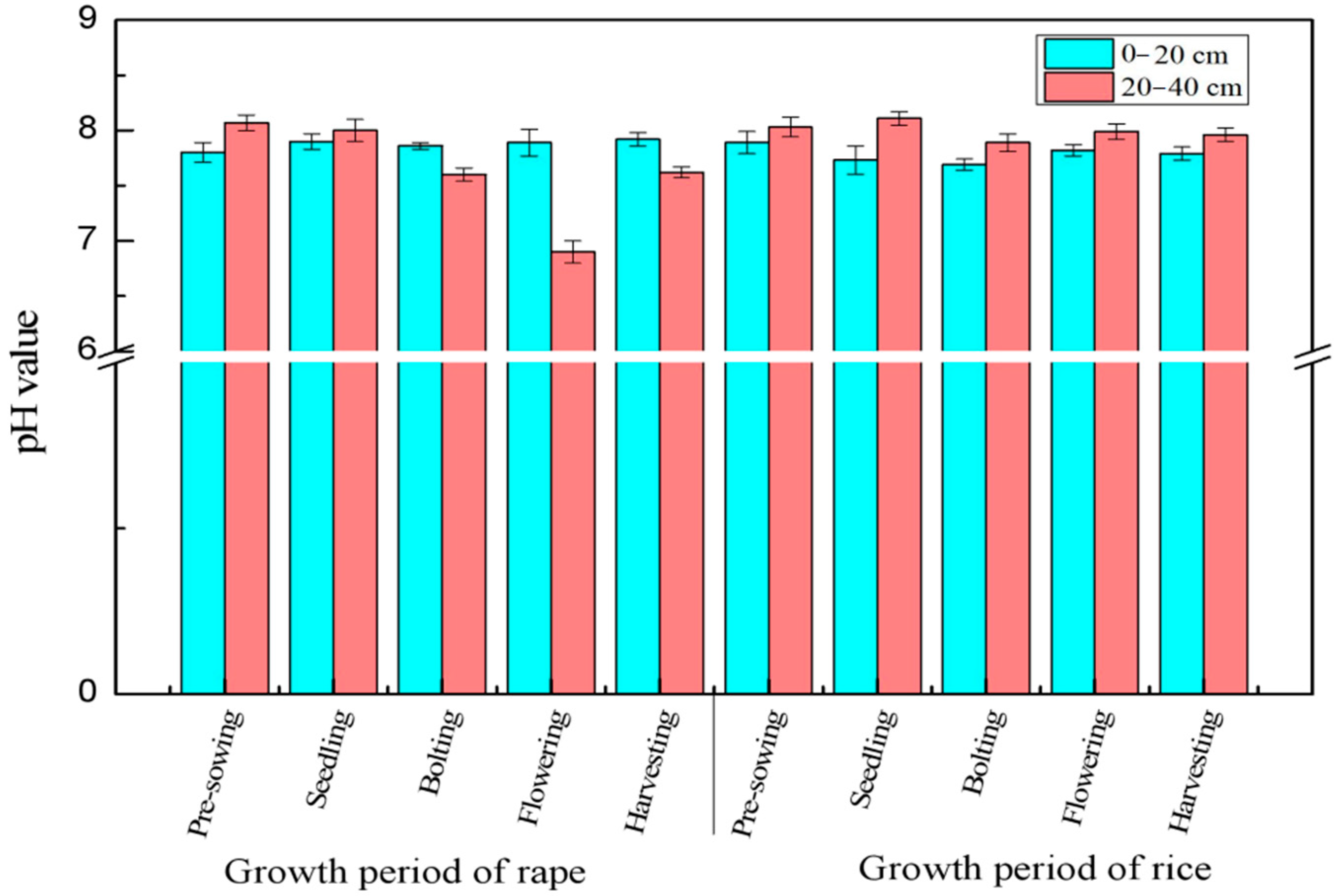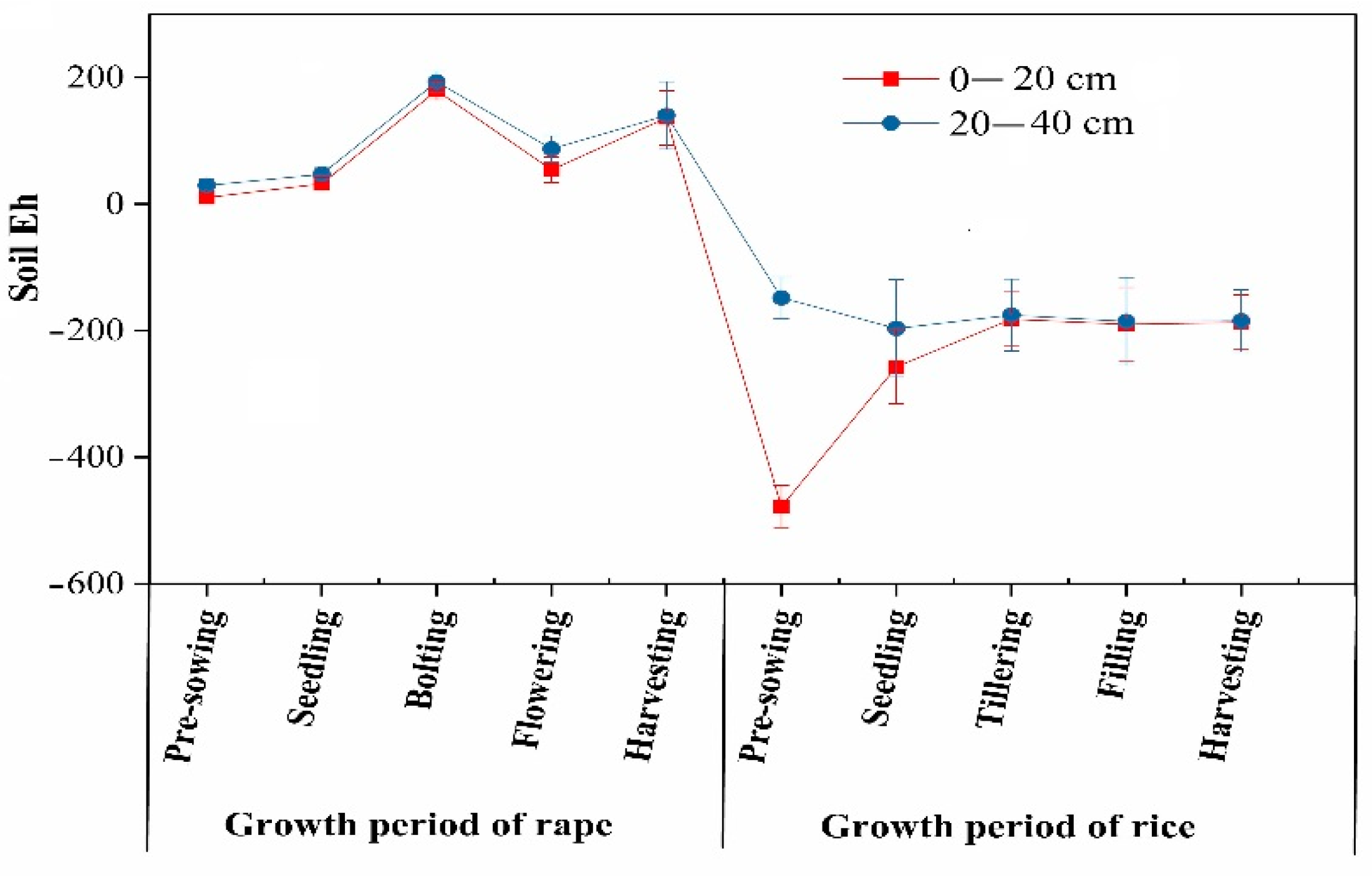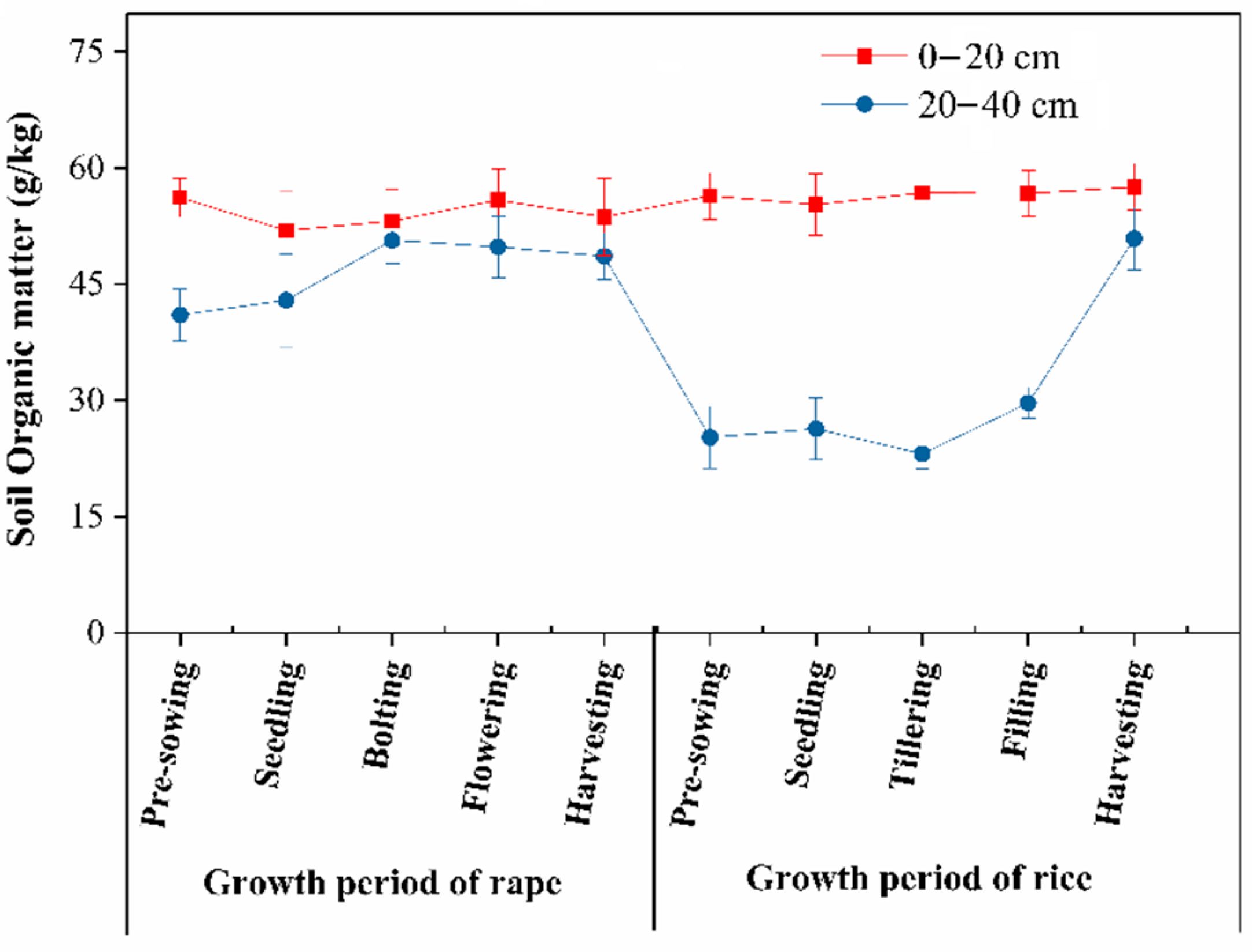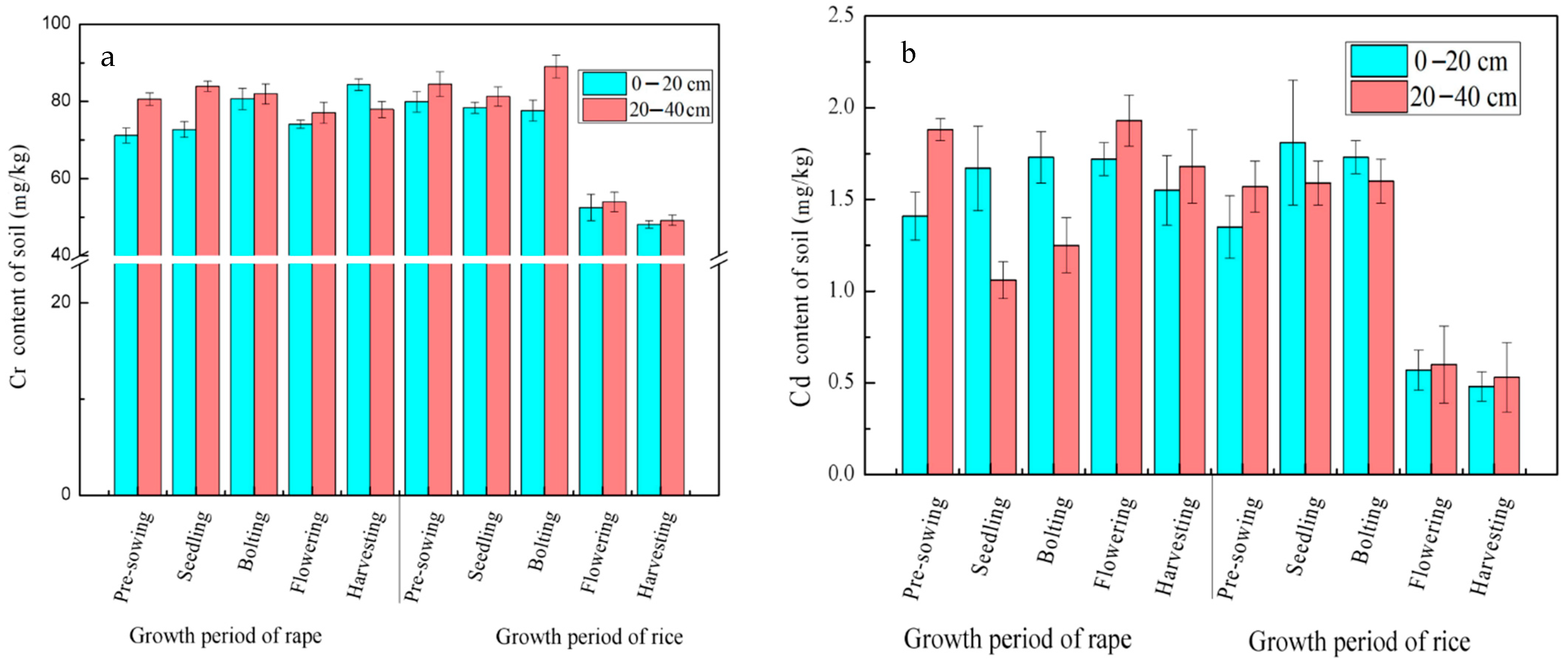Impacts of Rice–Rape Rotation on Major Soil Quality Indicators of Soil in the Karst Region
Abstract
:1. Introduction
2. Materials and Methods
2.1. The Experiment Material
2.2. Data Source and Sample Analysis
2.3. Evaluation of Heavy Metals in Soils
3. Results
3.1. Changes in the Physiochemical Properties of the Soil during Rice–Rape Rotation
3.1.1. Changes in the Mechanical Composition
3.1.2. Changes in pH
3.1.3. Changes in Redox Potential
3.1.4. Changes in Soil Organic Matter
3.2. Changes in the Heavy Metal Content of the Soil during Rice–Rape Rotation
3.2.1. Changes in the Cr and Cd Content of the Soil
3.2.2. Changes in the Pb and Cu Content of the Soil
3.3. Evaluation of the Soil Pollution by Heavy Metals in Rice–Rape Rotation
4. Discussion
5. Conclusions
Author Contributions
Funding
Institutional Review Board Statement
Informed Consent Statement
Data Availability Statement
Conflicts of Interest
References
- Dawe, D.; Steve, F.; Li, C.S. Trends in rice-wheat area in China. Field Crops Res. 2004, 87, 89–95. [Google Scholar] [CrossRef]
- Timsina, J.; Connor, D.J. Productivity and management of rice-wheat cropping systems: Issues and challenges. Field Crops Res. 2001, 69, 93–132. [Google Scholar] [CrossRef]
- Zhang, A.; Bian, R.; Hussain, Q.; Li, L.; Pan, G.; Zheng, J.W.; Zhang, X.H.; Zheng, J.F. Change in net global warming potential of a rice-wheat cropping system with biochar soil amendment in a rice paddy from China. Agric. Ecosyst. Environ. 2013, 173, 37–45. [Google Scholar] [CrossRef]
- Xu, Q.; Yang, L.Z.; Dong, Y.H. Rice Ecology Systems in China; Agricultural Press: Beijing, China, 1998. [Google Scholar]
- Ma, Y.J.; Chen, J.F. Change in Matter in Stagnic Anthrosols and Ecology Environment; Science Press: Beijing, China, 1999. [Google Scholar]
- Witt, C.; Cassman, K.G.; Olk, D.C.; Biker, U.; Liboon, S.P.; Samson, M.I.; Ottow, J.G. Crop rotation and residue management effects on carbon sequestration, nitrogen cycling and productivity of irrigated rice systems. Plant Soil 2000, 225, 263–278. [Google Scholar] [CrossRef]
- Sui, Y.; Gao, J.; Liu, C.; Zhang, W.; Lan, Y.; Li, S.; Mung, J.; Xu, Z.; Tang, L. Interactive effects of straw-derived biochar and N fertilization on soil C storage and rice productivity in rice paddies of Northeast China. Sci. Total Environ. 2016, 54, 203–210. [Google Scholar] [CrossRef]
- Villarreal-Núñez, J.E.; Barahona-Amores, L.A.; Castillo-Ortiz, O.A. Effect of zeolite on the nitrogen fertilizer efficiency in rice crop. Agron. Mesoam. 2015, 26, 315–321. [Google Scholar]
- Sándor, Z.; Kátai, J.; Tállai, M.D.; Varga, A.; Balogh, E. The effect of herbicides applied in maize on the dynamics of some soil microbial groups and soil enzyme activity. Cereal Res. Commun. 2007, 35, 1025–1028. [Google Scholar] [CrossRef]
- Gao, X.; Mohr, R.M.; McLaren, D.L.; Grant, C.A. Grain cadmium and zinc concentrations in wheat as affected by genotypic variation and potassium chloride fertilization. Field Crops Res. 2011, 122, 95–103. [Google Scholar] [CrossRef]
- Zhou, C.Y. Tillage in South of China; China Agricultural Press: Beijing, China, 1996. [Google Scholar]
- Fan, H.M.; Xu, M.X.; Li, B.B.; Zhang, R.R.; Zhang, S.M.; Ma, L.Y. Influence of soil physical properties on salt content in soil profile of farmland in WeiBei region. J. Soil. Water Conserv. 2017, 31, 198–204. (In Chinese) [Google Scholar]
- Zhang, Z.M.; Huang, X.F.; Zhou, Y.C. Factors influencing the evolution of human-driven rocky desertification in karst areas. Land Degrad. Dev. 2021, 32, 817–829. [Google Scholar] [CrossRef]
- Zhang, Z.M.; Huang, X.F.; Zhou, Y.C.; Zhang, J.C.; Zhang, X.B. Discrepancies in Karst Soil Organic Carbon in Southwest China for Different Land Use Patterns:A Case Study of Guizhou Province. Int. J. Environ. Res. Public Health 2019, 16, 4199. [Google Scholar] [CrossRef]
- Hu, Y.; Cheng, H. A method for apportionment of natural and anthropogenic contributions to heavy metal loadings in the surface soils across large-scale regions. Environ. Pollut. 2016, 214, 400–409. [Google Scholar] [CrossRef]
- Zhang, Z.M.; Zhang, Q.H.; Tu, C.L.; Zhang, J.C.; Lin, C.H.; Fang, H.; Wen, X.M. Effects on Heavy Metals in Karst Region Soil and the Enrichment Characteristics of Rice-Rape Rotation. Pol. J. Environ. Stud. 2019, 28, 4485–4493. [Google Scholar] [CrossRef]
- GB15618–1995; Maximum Levels of Contaminants in Foods. The Standardization Administration of the People’s Republic of China: Beijing, China, 2005.
- Chen, G.; Chen, Y.; Zhao, G.; Cheng, W.; Guo, S.; Zhang, H.; Shi, W. Do high nitrogenuse efficiency rice cultivars reduce nitrogen losses from paddy fields? Agric. Ecosyst. Environ. 2015, 209, 26–33. [Google Scholar] [CrossRef]
- Gholamhoseini, M.; AghaAlikhani, M.; Malakouti, M.J.; Joghan, A.K. Influence of zeolite application on nitrogen efficiency and loss in canola production under sandy soils conditions. Commun. Soil Sci. Plant Anal. 2012, 43, 1247–1262. [Google Scholar] [CrossRef]
- He, C.; Holme, J.; Anthony, J. SNP genotyping: The KASP assay. Methods Mol. Biol. 2014, 1145, 75–86. [Google Scholar] [PubMed]
- Guttieri, M.J.; Baenziger, S.P.; Frels, K.; Carver, B.; Arnall, B.; Wang, S. Prospects for selecting wheat with increased zinc and decreased cadmium concentration in grain. Crop Sci. 2015, 55, 1712–1728. [Google Scholar] [CrossRef]
- Manikandan, A.; Subramanian, K. Evaluation of zeolite based nitrogen nano-fertilizers on maize growth, yield and quality on inceptisols and alfisols. Int. J. Plant. Soil Sci. 2016, 9, 1–9. [Google Scholar] [CrossRef]
- Liu, J.; Zhu, Q.; Zhang, Z.; Xu, J.; Yang, J.; Wong, M.H. Variations in cadmium accumulation among rice cultivars and types and the selection of cultivars for reducing cadmium in the diet. J. Sci. Food Agric. 2005, 85, 147–153. [Google Scholar] [CrossRef]
- Wang, M.Y.; Xu, S.X.; Zhao, Y.C.; Shi, X.Z. Climatic effect on soil organic carbon variability as a function of spatial scale. Arch. Agron. Soil Sci. 2017, 63, 375–387. [Google Scholar] [CrossRef]





| Soil Depth | Index | Soil Organic Matter | Eh | pH | Pb | Cu | Zn | Cr | Cd |
|---|---|---|---|---|---|---|---|---|---|
| Mean | 56.19 | 10.2 | 7.8 | 44.54 | 19.54 | 81.72 | 56.19 | 1.41 | |
| 0–20 cm | Standard deviation | 2.38 | 12.62 | 0.09 | 4.37 | 1.22 | 1.23 | 2.38 | 0.13 |
| Coefficient of variation (%) | 4.24 | 123.73 | 1.15 | 9.81 | 6.24 | 1.51 | 4.24 | 9.22 | |
| Mean | 41.03 | 29.2 | 8.07 | 38.14 | 18.59 | 69.49 | 80.61 | 1.88 | |
| 20–40 cm | Standard deviation | 2.64 | 6.72 | 0.1 | 4.63 | 0.69 | 0.57 | 1.58 | 0.06 |
| Coefficient of variation (%) | 6.43 | 23.01 | 1.24 | 12.14 | 3.71 | 0.82 | 1.96 | 3.19 |
| Particle Size | 0–20 cm | 20–40 cm |
|---|---|---|
| Clay particles | 18.97 | 23.85 |
| Fine silt | 12.43 | 16.76 |
| Medium silt | 15.81 | 16.44 |
| Coarse silt | 35.21 | 34.06 |
| Fine sand | 14.96 | 6.64 |
| Coarse and medium sand | 2.64 | 2.26 |
| Soil Depth | Particle Size | Growth Period of Rape | Growth Period of Rice | Average Value | Coefficient of Variation | ||||||||
|---|---|---|---|---|---|---|---|---|---|---|---|---|---|
| Pre-Sowing | Seedling | Bolting | Flowering | Harvesting | Pre-Sowing | Seedling | Tillering | Filling | Harvesting | ||||
| 0–20 | Clay particles | 18.97 | 17.25 | 24.46 | 11.16 | 10.26 | 19.76 | 17.68 | 16.69 | 18.51 | 16.43 | 17.12 | 22.61 |
| Fine silt | 12.43 | 14.98 | 18.11 | 16.23 | 16.37 | 13.42 | 16.12 | 21.37 | 17.37 | 19.14 | 16.55 | 15.12 | |
| Medium silt | 15.81 | 17.87 | 18.62 | 17.55 | 15.23 | 20.49 | 19.66 | 17.52 | 17.37 | 18.51 | 17.86 | 8.44 | |
| Coarse silt | 35.21 | 32.53 | 31.82 | 33.67 | 26.43 | 30.37 | 30.99 | 31.15 | 29.74 | 27.87 | 30.98 | 7.94 | |
| Fine sand | 14.96 | 15.25 | 5.47 | 19.28 | 29.59 | 14.44 | 13.67 | 11.81 | 15.13 | 16.49 | 15.61 | 36.96 | |
| Coarse and medium sand | 2.64 | 2.13 | 1.51 | 2.11 | 2.11 | 1.53 | 1.88 | 1.46 | 1.88 | 1.56 | 1.88 | 19.03 | |
| 20–40 | Clay particles | 23.86 | 17.28 | 30.55 | 14.32 | 10.52 | 30.06 | 30.89 | 30.42 | 27.87 | 20.28 | 23.60 | 30.44 |
| Fine silt | 16.76 | 15.64 | 19.11 | 16.36 | 21.65 | 20.49 | 17.37 | 17.21 | 18.72 | 18.82 | 18.21 | 9.87 | |
| Medium silt | 16.44 | 17.68 | 19.21 | 15.65 | 10.52 | 27.87 | 19.45 | 18.15 | 16.22 | 15.91 | 17.71 | 23.40 | |
| Coarse silt | 34.06 | 31.59 | 28.72 | 33.14 | 34.83 | 16.43 | 28.70 | 30.63 | 29.12 | 30.37 | 29.76 | 16.47 | |
| Fine sand | 6.64 | 14.05 | 0.79 | 18.22 | 20.26 | 2.95 | 1.21 | 1.68 | 5.39 | 12.83 | 8.40 | 82.91 | |
| Coarse and medium sand | 2.26 | 3.76 | 1.61 | 2.31 | 2.23 | 2.20 | 2.38 | 1.91 | 2.67 | 1.79 | 2.31 | 24.37 | |
| Soil Depth | Element | Growth Period of Rape (Pi) | Growth Period of Rice (Pi) | PZ | Class of Pollution | ||||||||
|---|---|---|---|---|---|---|---|---|---|---|---|---|---|
| Pre-Sowing | Seedling | Bolting | Flowering | Harvesting | Pre-sowing | Seedling | Tillering | Filling | Harvesting | ||||
| 0–20 | Cr | 0.28 | 0.29 | 0.31 | 0.30 | 0.34 | 0.32 | 0.31 | 0.31 | 0.21 | 0.19 | 0.31 | Security |
| Cd | 2.35 | 2.78 | 2.88 | 2.86 | 2.59 | 2.26 | 3.01 | 2.88 | 0.95 | 0.79 | 2.70 | Moderate pollution | |
| Pb | 0.13 | 0.12 | 0.11 | 0.10 | 0.12 | 0.15 | 0.14 | 0.14 | 0.14 | 0.16 | 0.15 | Security | |
| Cu | 0.20 | 0.18 | 0.18 | 0.17 | 0.20 | 0.29 | 0.30 | 0.30 | 0.12 | 0.14 | 0.26 | Security | |
| Zn | 0.27 | 0.25 | 0.27 | 0.24 | 0.27 | 0.25 | 0.25 | 0.25 | 0.25 | 0.25 | 0.26 | Security | |
| 20–40 | Cr | 0.32 | 0.34 | 0.33 | 0.31 | 0.31 | 0.34 | 0.33 | 0.36 | 0.22 | 0.20 | 0.33 | Security |
| Cd | 3.14 | 1.76 | 2.09 | 3.22 | 2.81 | 2.62 | 2.64 | 2.66 | 1.01 | 0.88 | 2.79 | Moderate pollution | |
| Pb | 0.11 | 0.07 | 0.11 | 0.09 | 0.09 | 0.14 | 0.16 | 0.12 | 0.15 | 0.16 | 0.14 | Security | |
| Cu | 0.19 | 0.21 | 0.20 | 0.19 | 0.19 | 0.27 | 0.28 | 0.27 | 0.14 | 0.13 | 0.24 | Security | |
| Zn | 0.23 | 0.26 | 0.25 | 0.24 | 0.23 | 0.23 | 0.23 | 0.25 | 0.24 | 0.26 | 0.25 | Security | |
Publisher’s Note: MDPI stays neutral with regard to jurisdictional claims in published maps and institutional affiliations. |
© 2022 by the authors. Licensee MDPI, Basel, Switzerland. This article is an open access article distributed under the terms and conditions of the Creative Commons Attribution (CC BY) license (https://creativecommons.org/licenses/by/4.0/).
Share and Cite
Fang, H.; Yan, Q.; Zhang, Z.; Wang, D.; Huang, X. Impacts of Rice–Rape Rotation on Major Soil Quality Indicators of Soil in the Karst Region. Int. J. Environ. Res. Public Health 2022, 19, 11987. https://doi.org/10.3390/ijerph191911987
Fang H, Yan Q, Zhang Z, Wang D, Huang X. Impacts of Rice–Rape Rotation on Major Soil Quality Indicators of Soil in the Karst Region. International Journal of Environmental Research and Public Health. 2022; 19(19):11987. https://doi.org/10.3390/ijerph191911987
Chicago/Turabian StyleFang, Hui, Qiuxiao Yan, Zhenming Zhang, Daoping Wang, and Xianfei Huang. 2022. "Impacts of Rice–Rape Rotation on Major Soil Quality Indicators of Soil in the Karst Region" International Journal of Environmental Research and Public Health 19, no. 19: 11987. https://doi.org/10.3390/ijerph191911987
APA StyleFang, H., Yan, Q., Zhang, Z., Wang, D., & Huang, X. (2022). Impacts of Rice–Rape Rotation on Major Soil Quality Indicators of Soil in the Karst Region. International Journal of Environmental Research and Public Health, 19(19), 11987. https://doi.org/10.3390/ijerph191911987







